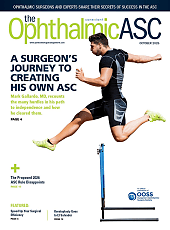Topcon Healthcare introduced the Tera Dry Eye Imager, a multimodal platform to detect, grade, and manage dry eye disease (DED). According to a company press release, Tera pairs robotic automation with high-resolution imaging to standardize capture and speed exams. The system integrates corneal topography, pupillometry, and a dedicated dry eye suite with validated clinical grading scales. In addition, it assesses both signs and symptoms at the point of care and turns results into clear, actionable guidance for treatment and follow-up, Topcon said.
According to Topcon, one-touch automated alignment, focus, and capture (with eye tracking where applicable) streamlines acquisition, while guided focus for meibography and tear meniscus heights supports reliable, high-quality images. A rotatable monitor that can be operated from either side of the patient further improves ergonomics and optimizes pre-test space to keep rooms flowing smoothly, the company said in the press release.
Clinicians get sharper, noninvasive views and a structured, standards-aligned path to pinpoint dry-eye drivers, explain findings, and guide treatment, the company said. In line with the DEWS III diagnostic framework,1 Tera pairs patient-reported symptoms (eg, OSDI-6) with objective measures such as noninvasive tear break-up time (NIBUT), ocular surface staining, and meibography, while high-resolution color imaging with patented diffused while light technology visualizes the ocular surface and tear film lipid layer.
According to Topcon, a modern interface with validated grading scales (Efron, Jenvis, Meiboscale) promotes consistent evaluations and clearer patient communication. By turning diagnostic data into a personalized, visual conversation, Tera helps patients better understand their condition and why therapies such as intense pulsed light (IPL) and radiofrequency (RF) may be recommended, the company said.
Reference
1. Wolffsohn JS, Benítez-Del-Castillo JM, Loya-Garcia D, et al. TFOS DEWS III: Diagnostic Methodology. Am J Ophthalmol. Published online May 30, 2025. doi:10.1016/j.ajo.2025.05.033









